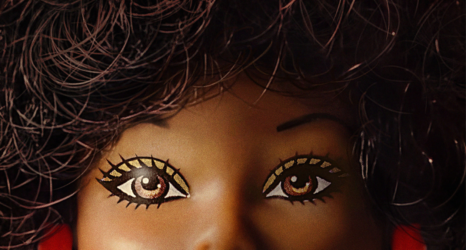My mother never addressed beauty in a critical way. In fact, beauty was rarely openly discussed in my house, but was the lingering weight on the shoulders of all the women in my family. The only times beauty was discussed was when my mother told me I needed to lose weight or when my grandmother told me I needed to “suffer to be beautiful.”
My critique of beauty came far too late in life, after the damage had already been done. Hole’s Courtney Love slapped me upside the head the first time I heard her belt out the lyrics to Doll Parts with gut-wrenching emotion, in her torn baby-doll dress and smeared lipstick .
I am doll eyes/ Doll mouth, doll legs/ I am doll arms, big veins, dog bait/ Yeah, they really want you, they really want you, they really do/ Yeah, they really want you, they really want you, they really do/ I want to be the girl with the most cake
Love stirred the festering agitation in me and eventually I was led to feminism’s door. I’ve been a body-image warrior ever since.
But what if a critical dialogue about the limited definitions beauty began early? Let’s face it: these conversations are necessary. Gender socialization does not occur in a vacuum, and even in the most conscious homes unrealistic images of beauty bombard our young people. Few parents can effectively combat the onslaught of conflicting values and norms perpetuated outside the home.
Barbie looms large as a pivotal figure in the lives of young girls. She is the epitome of the mainstream beauty standard, making an impact across race and class: She’s young, thin and, for the most part, white (while Mattel has created “ethnic” Barbie dolls, they sell in lesser quantities and, in the case of Wal-Mart, are sold for less money).
For more than 50 years, Barbie has remained an emblem of idealized femininity and a key element of gender socialization. Barbie fan Danielle Scott, 16, said:
Playing with the hair, the brushes, switching outfits. It really just made girls be girls.All the characteristics of what to look forward to and what girls really could do.
In those 50 years, Barbie has not waned in popularity (gained a pound, developed a wrinkle or gray hair), even in the face of mounting criticism. Rajini Vaidyanathan wrote at the BBC:
Despite some of the negative headlines Barbie is still a hit with girls across America and the world. … More than one billion dolls have been sold since her inception, and according to the doll’s makers, Mattel, 90 percent of American girls aged between three and 10 own at least one.
While it is true that Barbie is more complex than the Bratz (the googly-eyed dolls with a “passion for fashion”) and has had at least 125 jobs over the last half-century (jobs that presumably allowed her to purchase her multiple homes, extensive wardrobe and pink Corvette), Barbie is not famous for her extensive resume. Even Toy Story 3’s “renegade” Barbie doesn’t redefine Barbie’s cultural presence. Bottom line, Barbie is not defined by her career or the chutzpah she eventually taps into to help free Woody and the gang in Pixar’s latest. She is a timeless beauty icon. Period.
Generations after Mattel executive (and “kinky swinger”) Jack Ryan created Barbie, she continues to reinforce the beauty myth that pervades all aspects of the dominant culture. But with her alien measurements, Caucasian features, ivory skin, blond hair and unnaturally thin body how can anyone possibly measure up? I had a vintage Barbie scale fixed at 110 pounds, which would inform my notion of a woman’s ideal weight for most of my adult life.
Evelyn Ticona-Vergaray reports in “Barbie’s 50 years of beauty and controversy” on UPIU:
Studies made by the Wellness Resource Center at Vanderbilt University in Tennessee confirmed that a human version with Barbie’s body proportions would only have room for an esophagus or a trachea in her neck, a tibia or a fibula in her legs, and that she would have to crawl to support her top-heavy frame.
Academics from the University of South Australia suggest that chances of finding a woman having Barbie’s body shape is one in 100,000. Moreover, researchers at Finland’s University Central Hospital say if Barbie were a real woman she would lack the 17 to 22 percent of body fat required for a woman to menstruate.
Most girls and women could never and will never look like Barbie although many try (and some try harder than others). So, as an ambassador of a twisted yet omnipresent beauty norm, it’s no wonder that Barbie is subject to “torture play.” Ticona-Vergaray also wrote:
Research found in the article “Early adolescents’ experiences with, and views of, ‘Barbie’” revealed a high rate of “torture play” and “anger play” associated with the Barbie doll. Girls admitted to blaming the image of Barbie for their self-consciousness and lack of self esteem due to the simple impossibility of living up to the standards of beauty presented by the plastic doll.
Most anger play is played out in private, with little dialogue or social commentary to accompany the cut hair, dismembered appendages and pins shoved through her cheeks. But recently, my friend Justine showed me pictures of the anger play perpetrated by her pint-sized 9-year-old daughter (lovingly nicknamed the “Barbie executioner”). Together, mother and daughter turned this anger play into artistic self-expression and social commentary.
Justine, a self-identified feminist, knew there was trouble the first time her then-five-year-old daughter requested a Barbie after she saw one at a friend’s house. Justine, an outspoken, self-assured woman with a personal disdain for Barbie who also teaches a class to young girls called “Tapping the Body’s Wisdom,” was quick to discuss her feelings about Barbie’s “unrealistic portrayal of feminine beauty” as something not worth “aspiring to.”
Mother and daughter critically discussed images of beauty and how the image of Barbie made them feel. Her daughter acknowledged that she did not look like Barbie. In fact, she acknowledged that no dolls looked like her and, in the end, she consciously acknowledged that she did not want to be that doll. Shortly thereafter, her daughter began to take apart her Barbies (and Bratz dolls) and would play with their heads and appendages alone. After her daughter racked up a pile of doll parts, Justine suggested saving the appendages for a future art project. Eventually, Justine provided her daughter with a canvas and her daughter pored through beauty magazines to find words to express her feelings.
The result?
The inception, process and end result inspired me. I was moved by her 9-year-old’s ability to take the “smallness” Barbie made her feel, a feeling that too often remains silent and is internalized, and articulate it loudly on canvas. We may have a limited measure of control over the images our daughters are exposed to, but we still can help them cultivate a critical consciousness, use their voice and develop a healthy body image.
An earlier version appeared at Feminist Fatale as Doll Parts: Barbie, Beauty and Resistance.
Photos courtesy of Justine Amodeo.





